North America boasts two native crane species, the Whooping Crane (Grus americana) and the Sandhill Crane (Antigone canadensis). Even though there are several physical similarities to these birds, they are very genetically, physically, and behaviorally distinct from one another.
In this article, I hope to give you the skills you need to know if you are looking at a Sandhill Crane or the endangered Whooping Crane. But before we talk about how to distinguish between them, let’s get to know our subjects of study.
Whooping Crane (Grus americana) – America’s Crane
The Whooping Crane is the largest native North American bird. Standing nearly five feet tall and weighing sixteen pounds, these massive white cranes tower over any species around them.
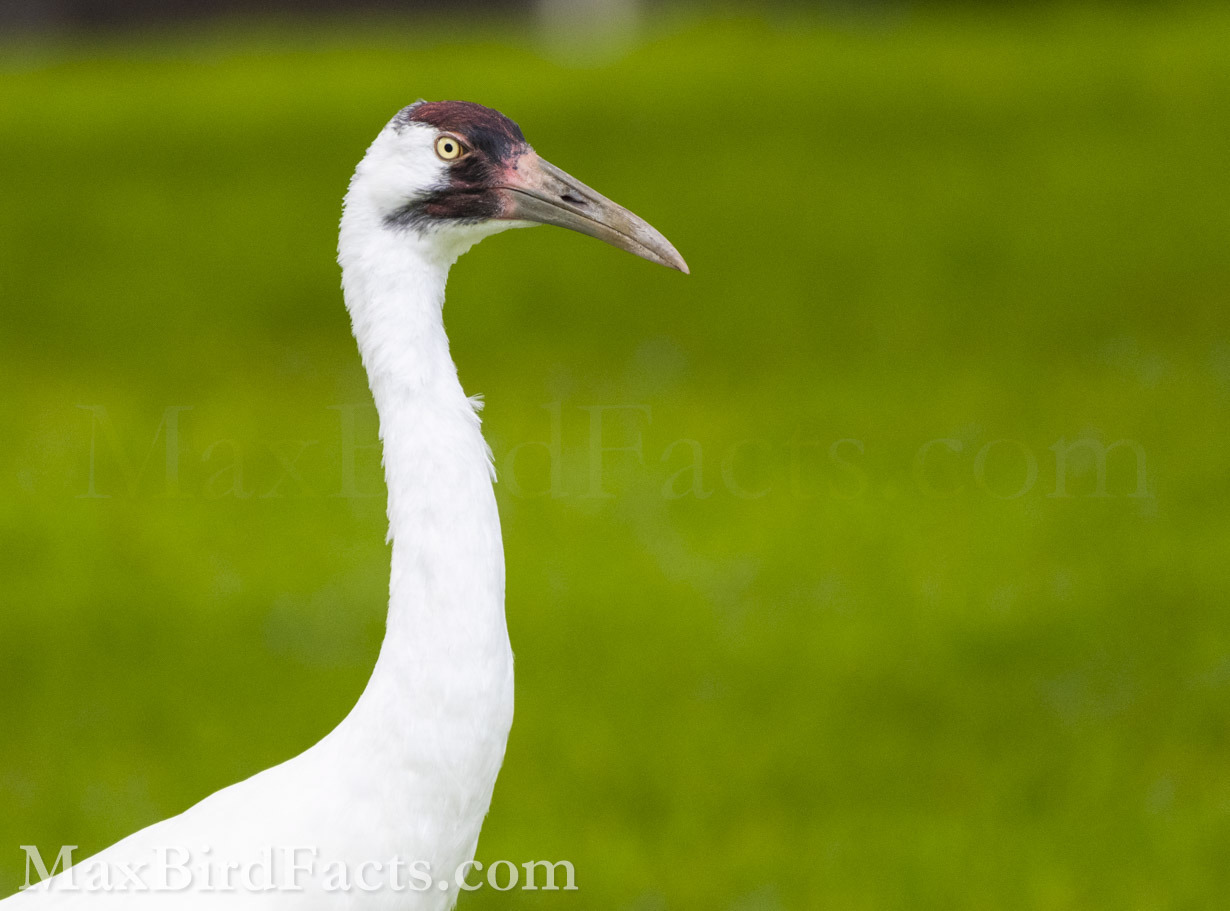
Whooping Cranes have very flexible diets, enjoying corn and other agricultural spillages, along with insects and even the occasional fish. Their brilliant white plumage makes their enormous bodies stand out distinctly while probing with their beaks.
However, these massive birds almost went extinct in 1941, with less than 20 birds left in the wild. Thankfully, over the next fifty years, 415 eggs were collected, hatched, and raised in the hopes of returning these magnificent birds to the wild.
In 1999, Operation Migration USA started raising Whooping Crane chicks in Wisconsin to teach them their ancient migration routes to Florida. Two years later, the first ultralight lead flight from Wisconsin to the Sunshine State succeeded, and in 2005 they started releasing yearling birds with veteran migrants to learn their path from the older birds.
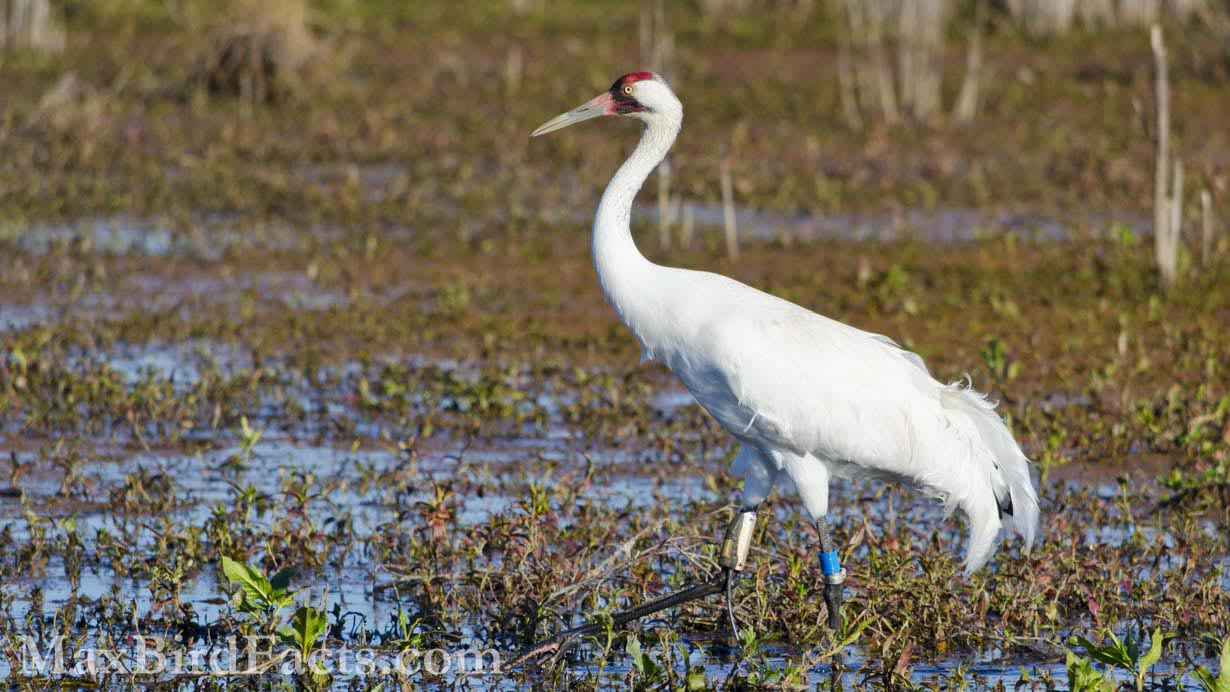
Today, a little over 400 wild Whooping Cranes across North America still make our part of the world unique. The work done by ornithologists and conservationists has ensured a place for future generations to admire and relish these birds.
Still, the Whooping Crane is the second-rarest bird in the United States and Canada, so their continued protection and support are obviously required.
If you’d like to learn all about the Whooping Crane, check out my article, 11 Facts About Whooping Cranes – Hand Puppets, Ultralights, and the Rarest Bird.
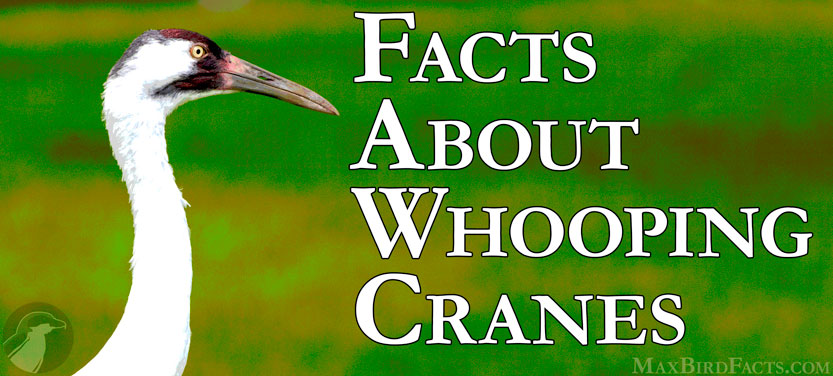
Sandhill Crane (Antigone canadensis) – Canada’s Crane
Sandhill Cranes, though not as tall as Whooping Cranes, are immense birds at three and a half feet tall and with a wingspan of over six feet. They are also a little lighter than Whoopings, weighing about fourteen pounds.
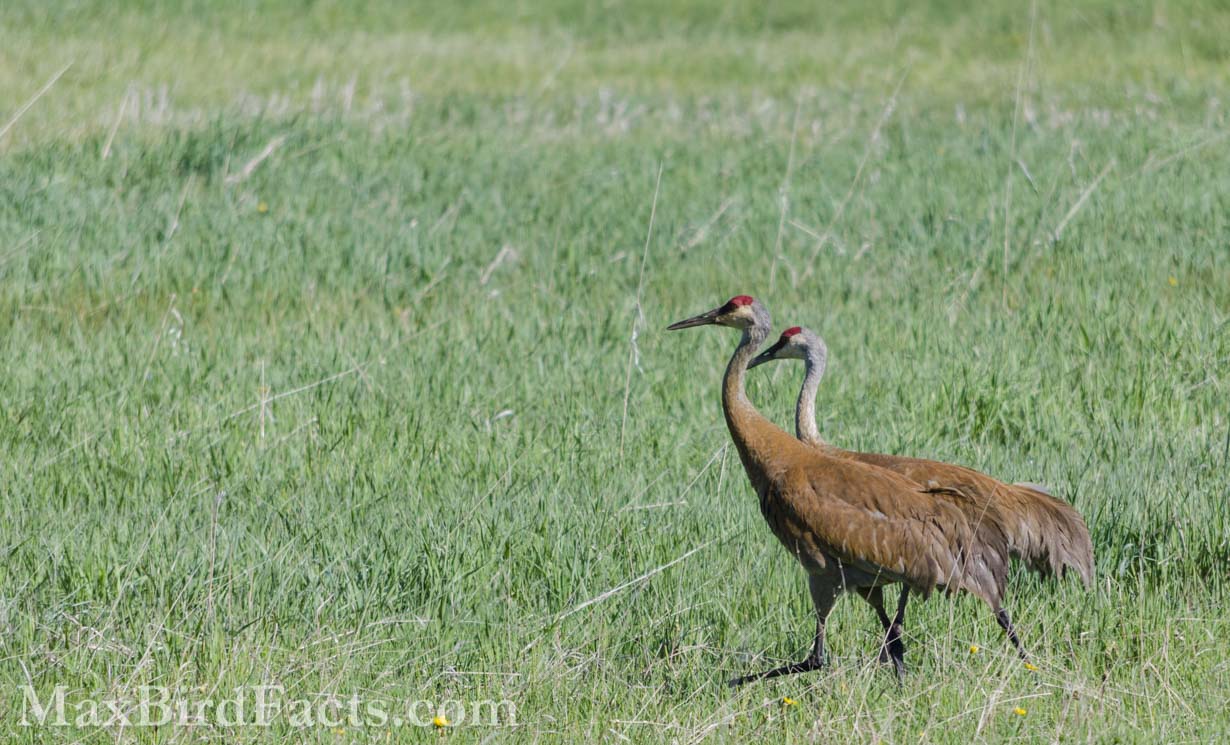
These smaller gray cranes are similarly flexible with their diets. They enjoy corn and wheat during their fall migratory stopovers in Nebraska while happily stabbing at insects and reptiles when the opportunity presents itself.
Unlike the Whooping Crane, the Sandhill Crane’s population is vigorous and well-established. Still, cranes vanished in several regions of their historic territory during the turn of the 20th century, and those populations are still recovering.
Today, there are between 500,000 to 800,000 Sandhill Cranes across North America. Their population spans over six subspecies, the most numerous being the Lesser Sandhill Crane (A. c. canadensis), with numbers between 300,00 – 500,000 individuals, compared to the critically endangered Cuban Sandhill Crane (A. c. nesiotes) of less than 300 birds.

I feel the need to restrain myself from going into further details about Sandhill Cranes since I have written about these majestic birds at length in previous articles. Still, I urge you to read more about these amazing avians if you are as enthralled with them as I am.
So, below, I’ve linked three of my pieces that I think cover some of the most engrossing aspects of Sandhill Cranes for your enjoyment! Before you go, don’t forget to return to this article once you’ve finished learning about the fascinating lifestyle of the Sandhill Crane.
Where Do Sandhill Cranes Sleep – Lost Toes and Frigid Rivers

What Do Sandhill Cranes Eat – Eating Bugs For Growth

Do Sandhill Cranes Mate For Life – The Strength Of Love

Now, without further delay, let’s learn how to distinguish between Whooping Crane vs. Sandhill Crane.
Whooping Crane vs. Sandhill Crane Body Plumage
By far the most striking difference between a Whooping Crane and a Sandhill Crane is their aspect. Aspect refers to the coloration of a bird’s feathers.
Whooping Cranes are beautiful white birds with contrasting black primary flight feathers. Compare this to the soft gray aspect of the Sandhill Crane, with patches of tawny feathers throughout their wing coverts, back, and neck.
The way I learned the color to look out for when I was young was White for Whooping. These simple alliterations helped me memorize key features to recall when identifying similar species (e.g., Arrow for Anhinga and Curved for Cormorant).
The color difference between a Whooping Crane and Sandhill Crane should be your first indicator of which species you are observing.
If the bird you are looking at has its head down foraging or is sitting on a nest sleeping with just its back exposed, you can still identify it readily by looking at its coloration. This same rule is true for cranes in flight.

Sandhill Cranes are lighter gray on their ventral aspect but nowhere close to the pure white of a Whooping, and rusty feathers often speckle their breast and belly. Sandhill Cranes have much fewer identifying markings on their wings than their larger cousins, the most notable being their uniform gray appearance and darker trailing edge.
I should note that the rusty or tawny coloration seen in the Sandhill Crane’s aspect isn’t the natural color of the feathers; it is simply from the crane rubbing soil into its feathers. As the mud and dirt oxidize, it creates the array of browns and oranges the birds use to accentuate their otherwise drab plumage.
Why Sandhill Cranes add these pigments into their aspect has yet to be fully understood. These splotches of earthy tones could act as camouflage when the crane is on a nest, or it could be a way for the bird to appear more attractive to potential mates or partners.
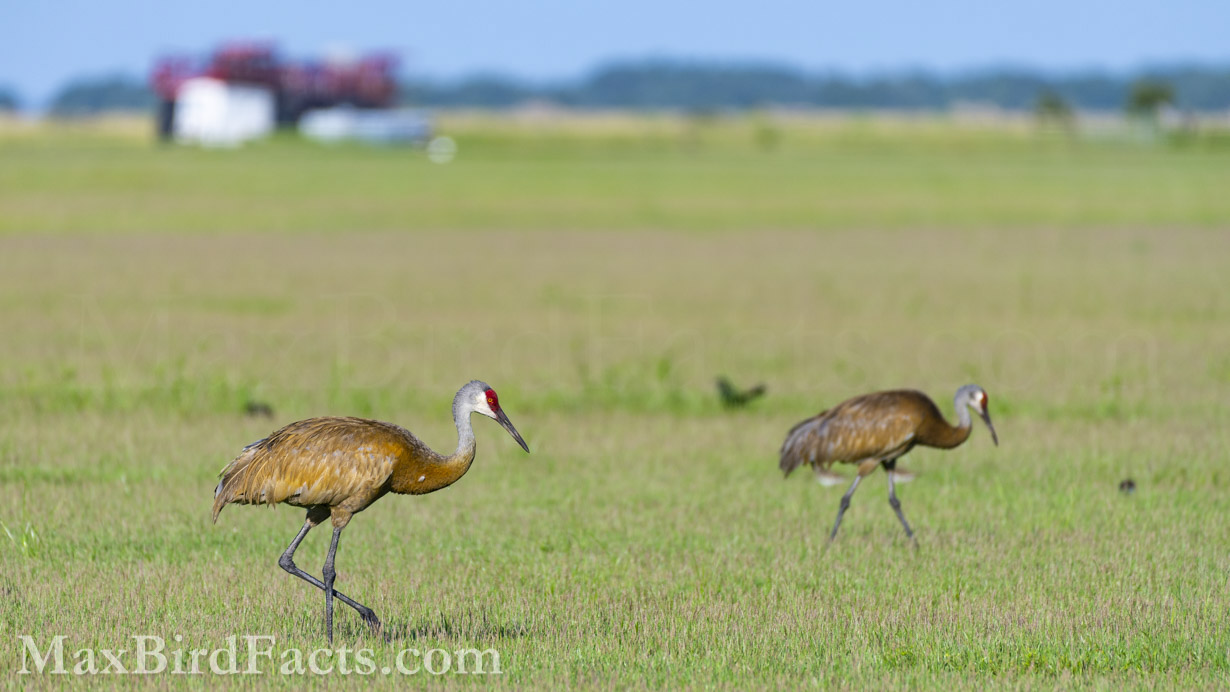
Regardless of the Sandhill’s rationale for this ornamentation, Whooping Cranes pride themselves on their spotless plumage. Even though both species eat, sleep, and nest in nearly the same areas, Whooping Cranes reserve themselves from becoming dirty, purposeful, or not.
Whooping Cranes have an almost wholly white ventral aspect (view from below), with the only different colors being their black primary flight feathers on the wings, sometimes called fingertips. These black feathers are also visible dorsally on the birds, with their alula also being dark gray to black.

This feather aspect might seem obvious to try and remember, but sometimes the most obvious features are the first we need to remember. I often find myself looking for the more subtle identifying markings on birds with similar-looking counterparts in that area rather than something that might be more obvious.
I think it is vital to always find the quickest route to positive identification, and the plumage aspect of a white Whooping Crane and a gray Sandhill Crane is just this. Again, simply keep the alliteration White for Whooping in mind.
Still, we must discuss the second and much more intricate piece of identifying a Whooping Crane vs. Sandhill Crane.
Whooping Crane vs. Sandhill Crane Head, Crown, and Beak
To gain an accurate view of a Whooping Crane’s head is no small feat. John James Audubon wrote that if a “Hooping” Crane were to “perceive a man approaching, even at the distance of a quarter of a mile, they are sure to take to wing.”
However, if you are fortunate enough to gain a clean look at a crane’s head and can’t quite remember what color you should be looking for (remember White for Whooping), look for the extent of the facial skin on the crane.
Whooping Cranes have very extensive exposed facial skin. Their bare red flesh extends from the base of their mandible (lower jaw) and maxilla (upper jaw), stretching above their eyes to the crown and the corners of their mouth.
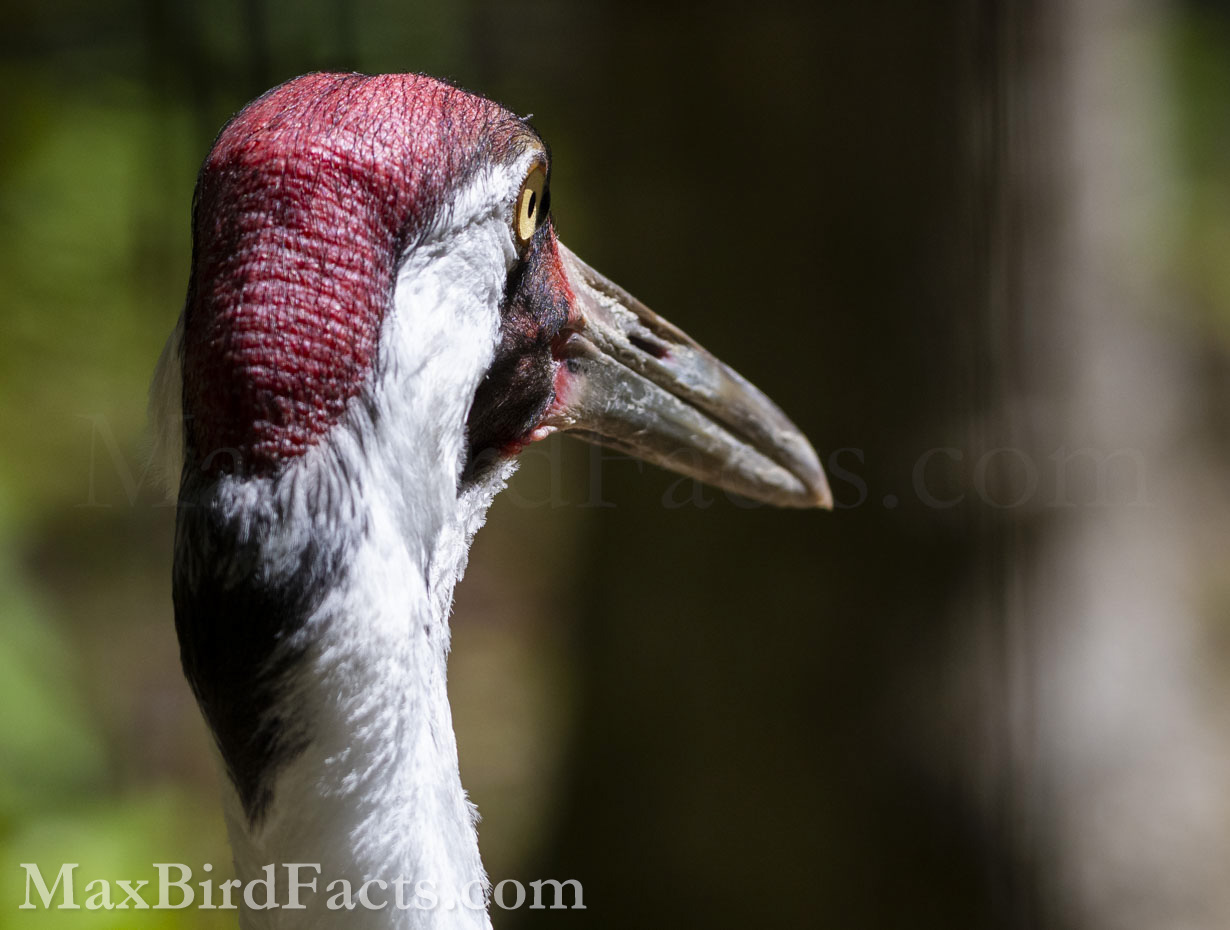
Fine, hairlike black feathers cover most of the skin on a Whooping Crane’s cheeks and crown, though their crimson skin is still readily visible. These black feathers typically edge the crane’s face and act as a border before the white plumage begins.
Though the Sandhill Crane’s exposed skin covers less area, it makes up for this with vibrance. The Sandhill’s crimson cap extends from the base of the maxilla to completely encompass the bird’s eye and terminates at the crown.
Like the Whooping, the Sandhill also shows fine hairlike feathers on its crown, though theirs are much shorter and far less noticeable. This is important because Sandhill Cranes flush blood into their bare crowns to make them more impressive to attract mates and deter rivals.
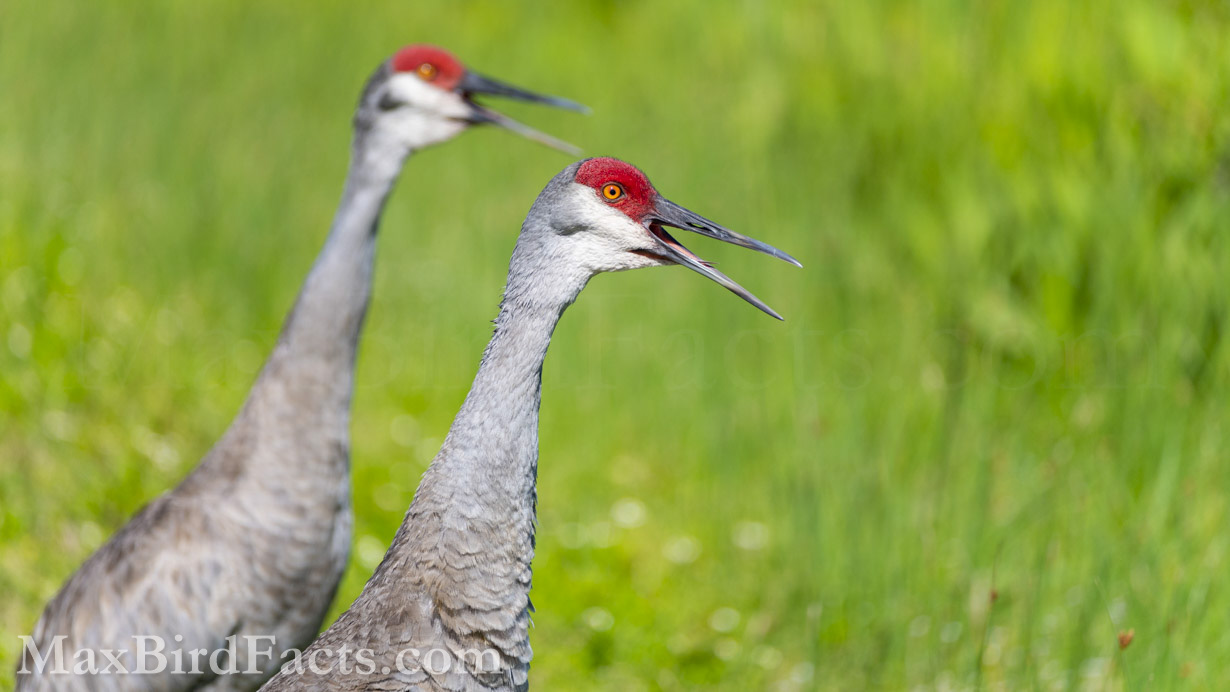
The beaks are strikingly different between these two species, even though their lifestyle is nearly identical.
The Whooping Crane’s beak is dull gray, with the maxilla having a noticeable downward curve near its tip. Conversely, the Sandhill Crane’s beak is steely gray with no discernable curves, making it perfectly pointed for probing.
The skin around the base of the beak on the Whooping is noticeably pink compared to the Sandhill’s gray flesh.
Eye coloration of these two species is another good indicator.
Whooping Cranes have straw-yellow eyes compared to the blazing orange eyes of the Sandhill. However, like people, the crane’s eye color is highly variable.
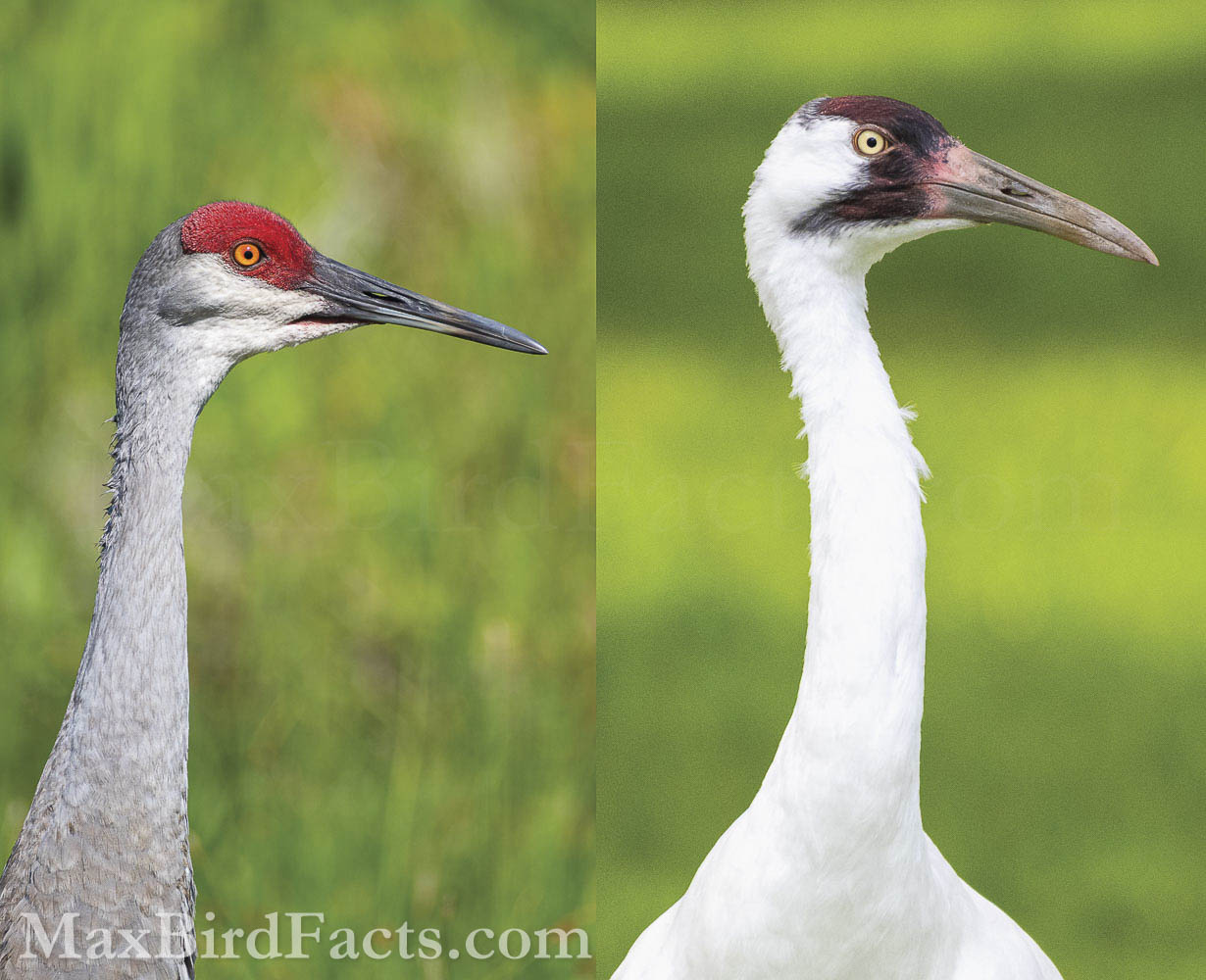
There are several images of Whooping Cranes with orange eyes and a few photos of Sandhill Cranes with yellow-orange eyes. Still, the trend seems consistent: the intensity of the Sandhill Crane’s eyes is greater than the Whooping Crane’s.
But, if you can see the colors of the crane’s eyes, you should have already determined which species it is. So, again, go back to the color of the bird’s overall plumage rather than these minute and sometimes trivial details.
Other Similar Species
You might be as surprised as I was when finding that Snow Geese (Anser caerulescens) and American White Pelicans (Pelecanus erythrorhynchos) are two apparently frequent candidates for misidentified sightings of Whooping Cranes.
I initially thought there was no way even a beginner birder could mistake a Snow Goose for a Whooping Crane. But thankfully, this oddity makes more sense because these mix-ups are usually from birds soaring at great heights.
Since all three species share extremely similar colors when flying, I can see how anyone could make this mistake without noticing a few subtle details.
Below is an image with all three subjects of discussion: Snow Goose, Whooping Crane, and American White Pelican. The two things to notice between these three species are the length and position of their legs in flight and the amount of black on their wings.
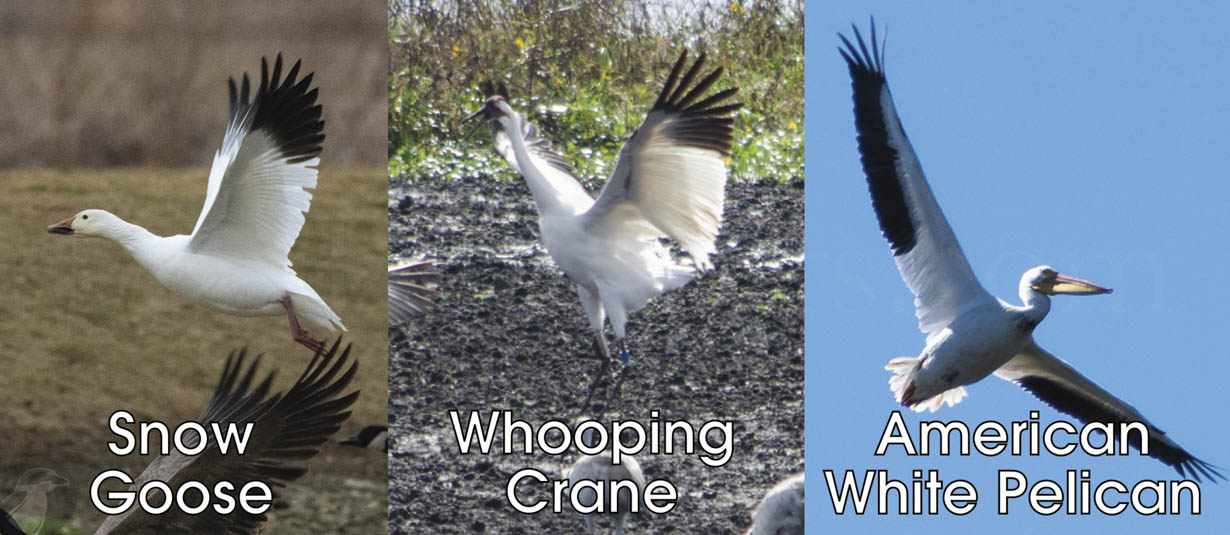
The Whooping Crane has an elegant, slender appearance with long, broad wings and lengthy legs. In flight, the crane holds its head straight ahead and its legs trailing behind. This position gives the bird excellent aerodynamics while giving us a very distinct profile to look for.
As mentioned earlier, only the primaries on a Whooping Crane are black, while the rest of the bird is pure white. The wings of a crane are also fairly rounded, even with its seven-foot wingspan, and the most distal primaries spread apart like fingertips on the Whooping Crane.
Now, the Snow Goose has similarly shaped wings, with the amount and location of black in its primaries nearly identical to the crane. Yet, the goose has a much more compact, rotund body and a shorter, thicker neck.
However, the primary indicator is the lack of trailing feet in the Snow Goose. Yes, an injured bird could hold its leg limply behind it, but most, if not all, geese fold their legs into their body during flight. This action is impossible for Whooping Cranes since their legs are far too long to tuck away.
Next, the American White Pelican can almost pass for the crane if it sticks its neck out. Thankfully, pelicans prefer to fly with their heads tucked into their shoulders, so this is rarely an issue.
Still, their long neck and bill can make the identification of the front of the bird tricky, so focus on the back. Like the goose, the pelican tucks its feet during flight for better performance.
Additionally, the black on the pelican’s flight feathers extends way too far to pass for a crane, going over halfway down the length of the wing. Further, the pelican’s wings are nothing similar to the crane’s.
The American White Pelican’s wings have a much higher aspect ratio (long, thin, and pointed tips) than the Whooping Crane’s lower aspect ratio (still long but broader and more rounded ends).
The pelican’s wings perfectly reflect its oceanic lifestyle, requiring long periods of efficient soaring over the waves to hunt shoals of fish. However, the crane can land and rest or feed in a field whenever it desires and might need a hasty retreat when a terrestrial predator arrives, warranting its broad, powerful design.
So, again, if you have a Whooping Crane in your binoculars or camera viewfinder, look for those black primaries on long, rounded wings and a long slender neck with its legs trailing behind.
Now We Know The Difference Between Whooping Crane vs. Sandhill Crane!
Hopefully, you’ve learned some new tricks to look out for when identifying a Whooping Crane vs. Sandhill Crane.
First, look at the aspect of the crane’s plumage. Remember White for Whooping!
Second, look at the bird’s head, crown, and beak. If exposed skin is coming from the base of the mandible, and fine hairlike feathers cover that exposed flesh, you have a Whooping Crane.
Also, be wary of Snow Geese and American White Pelicans when identifying a possible Whooping Crane. If the bird’s legs are trailing behind it, and the black markings on the wings are only on its primary flight feathers, you have a Whooping Crane!
Remember to look at both the obvious and more discreet features of the bird in question. Even a subtle clue might hint at the correct species, and this applies to all birds, not just Whooping Cranes vs. Sandhill Cranes.

Finally, if you are lucky enough to have a close view of North America’s second most endangered bird, cherish it and give the bird its space.
The last thing you want to do as a birder is stress out the animal. This will affect its behavior and both your and the bird’s enjoyment of your mutual experience.
Thank you so much for reading this article on Whooping Cranes vs. Sandhill Cranes; I really hope you learned something from it!
If you have ideas or suggestions for topics you would like me to write about in the future, feel free to leave a comment below or shoot me an email!
If you enjoyed this article, please subscribe to my email list to be the first to know when I post new articles!
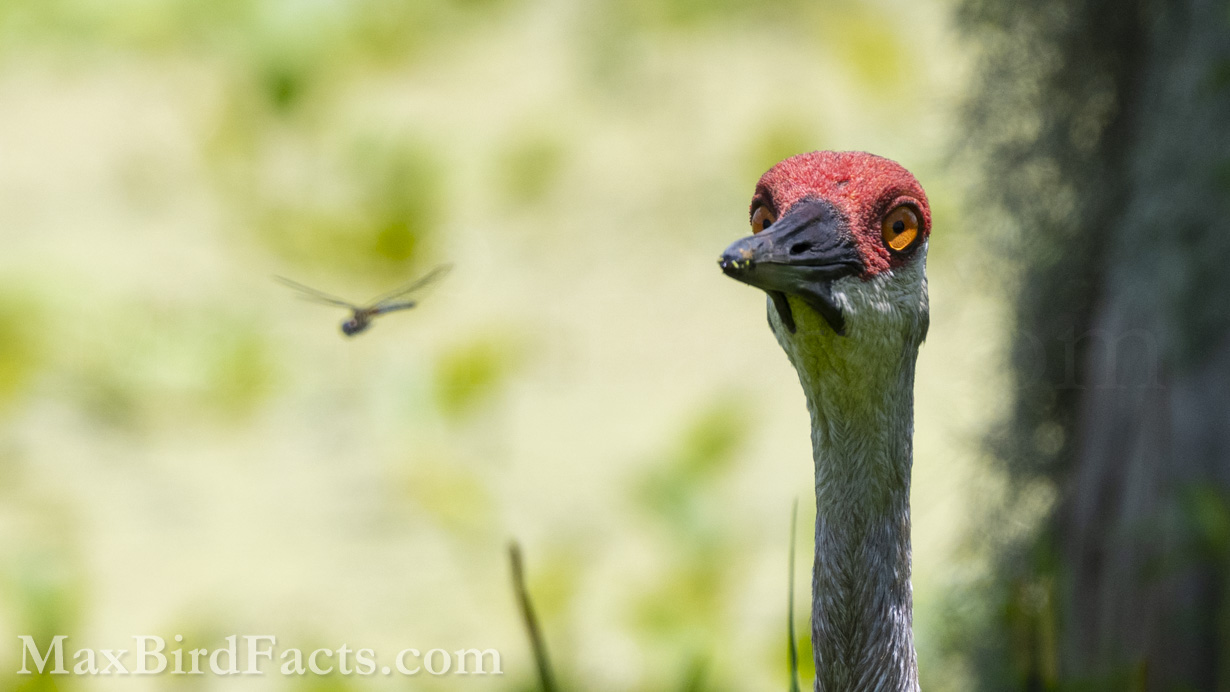
Get Outside & Happy Birding,
Max
Discover more from Welcome to MaxBirdFacts.com!!!
Subscribe to get the latest posts sent to your email.
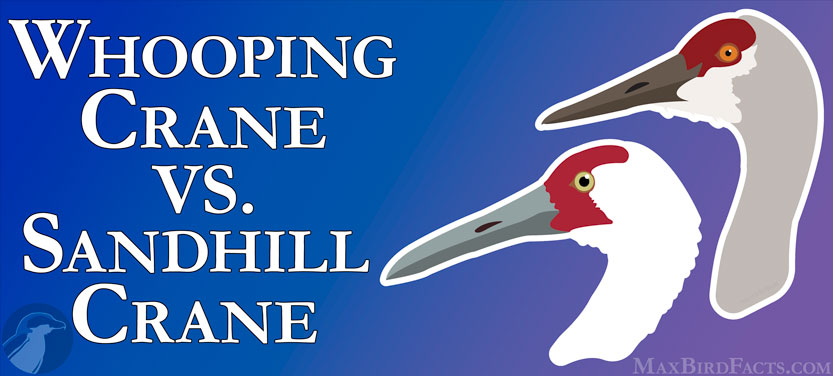
Pingback: 11 Facts About Whooping Cranes – Hand Puppets, Ultralights, And The Rarest Bird – Welcome to MaxBirdFacts.com!!!